Research Highlights
Patent Summary
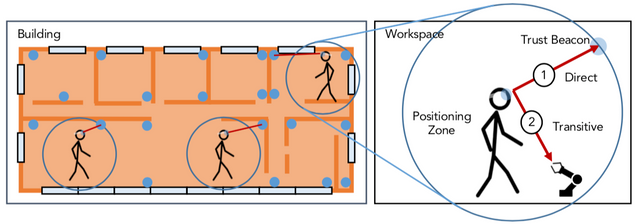 Zone Based Positioning System (2022) — Proposed is a system and method for enabling high-accuracy indoor positioning from the perspective of a moving user device. A carried device, called a Zone Positioning Unit (ZPU) determines position with respect to anchor points (Trust Beacons).
Zone Based Positioning System (2022) — Proposed is a system and method for enabling high-accuracy indoor positioning from the perspective of a moving user device. A carried device, called a Zone Positioning Unit (ZPU) determines position with respect to anchor points (Trust Beacons).
The combination of ZPU and Trust Beacons allows deployment of high-resolution areas of an indoor space to meet different application requirements. Detailed overview (PDF).
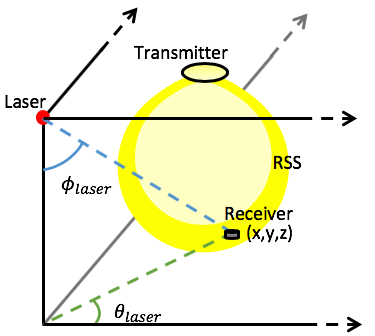 Ray-Surface Positioning (2020) — Proposed is an indoor Visible Light Positioning system that augments light emissions from luminaires (lights) with a steerable laser. By knowing the exact angles between the laser and the receiver being positioned (via free space optical communication) as well as received-signal-strength (RSS) from one or more luminaire sources, we can predict the position of the receiver in 3-dimensions.
Ray-Surface Positioning (2020) — Proposed is an indoor Visible Light Positioning system that augments light emissions from luminaires (lights) with a steerable laser. By knowing the exact angles between the laser and the receiver being positioned (via free space optical communication) as well as received-signal-strength (RSS) from one or more luminaire sources, we can predict the position of the receiver in 3-dimensions.
By using angles we show a significant reduction in error all the way to zero (width of the laser) in 2-dimensions. This technique can operate using a single luminaire, making it more versatile than other RSS-based approaches for establishing receiver position especially in 3D. Detailed overview (PDF).
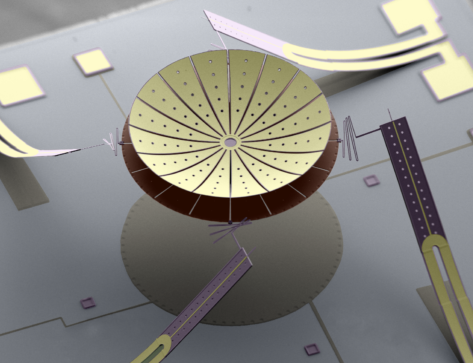
MEMS Devices for Smart Lighting Applications (2019) — This invention relates to devices and systems comprising micro mirrors that can be actuated through thermal, electro-thermal, or magnetic means. With the use of such a device, light can be effectively redistributed from an LED source providing (a) controlled directional optical communications and (b) redistribution of light in a smart, reconfigurable or dynamic illumination system.
The technology has been demonstrated in an electro-thermally-controlled mirror capable of variable focus, tilting and tipping (i.e., pitch and roll), and “piston” (variable height). Patent.
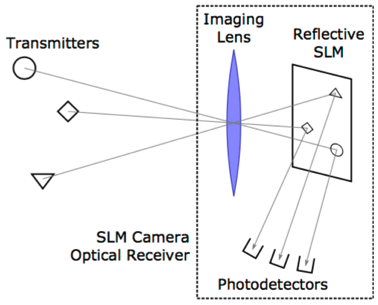 Visible Light Communications Receiver (2019) — This invention describes an optical wireless receiver that is capable of tracking multiple incident signals originating from different transmitters. This is particularly useful for mobile receivers such as smart phones, or for receivers able to aggregate capacity by using multiple data sources.
Visible Light Communications Receiver (2019) — This invention describes an optical wireless receiver that is capable of tracking multiple incident signals originating from different transmitters. This is particularly useful for mobile receivers such as smart phones, or for receivers able to aggregate capacity by using multiple data sources.
The approach is embodied in a device that uses a spatial light modulator (SLM) such as a mirror array to redirect incident optical signals onto a set of photodetectors. By dynamically controlling the SLM, the incident light can be steered and focused onto individual detectors and thus can maintain continuous link connectivity under device orientation changes. The technology has been demonstrated using a DLP array and can be adapted into different topologies depending on need. Patent.
Sensory Lighting System and Method for Characterizing an Illumination Space (2016) — This invention describes a system and technique for using an array of light sources to illuminate a space and to interpret the reflected signals using an array of light sensors. The goal of this approach is to create an elevation map of objects within the space and to identify the disposition of objects present. Patent.
System and Method for Embedding Phase and Amplitude into a Real-Valued Unipolar Signal (2019) — This invention addresses the nature of improving spectral efficiency of encoding data onto an intensity modulated (IM) light signal which is common in optical communications including for free-space, optical fiber, and visible light communications. The system includes a complex-to-unipolar conversion engine configured to receive complex symbols in Cartesian format and convert the complex symbols from the Cartesian format to a polar coordinate format and generate real valued unipolar symbols including embedded phase and amplitude information of complex symbols in the Cartesian format. The net of this is to substantially increase the amount of data than can be conveyed by the optical channel (spectral efficiency). Patent.
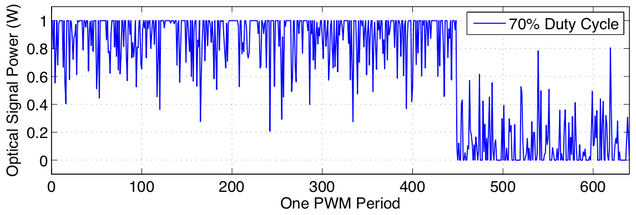 Optical Orthogonal Frequency Division Multiplexing (O-OFDM) System with Pulse-Width Modulation (PWM) Dimming (2017) — This invention introduces a means to provide dimming in lighting systems that are designed for both illumination and optical communications. Essentially two modulation techniques are combined to (a) provide spectrally-efficient modulation (OFDM) and light dimming (PWM). The benefit is to exploit existing LED lighting components that already use PWM while incorporating the best features of OFDM for encoding data onto the light. Patent.
Optical Orthogonal Frequency Division Multiplexing (O-OFDM) System with Pulse-Width Modulation (PWM) Dimming (2017) — This invention introduces a means to provide dimming in lighting systems that are designed for both illumination and optical communications. Essentially two modulation techniques are combined to (a) provide spectrally-efficient modulation (OFDM) and light dimming (PWM). The benefit is to exploit existing LED lighting components that already use PWM while incorporating the best features of OFDM for encoding data onto the light. Patent.